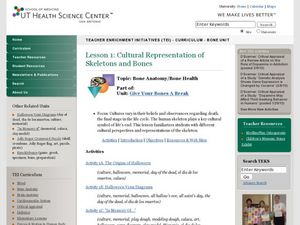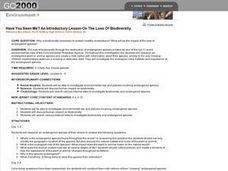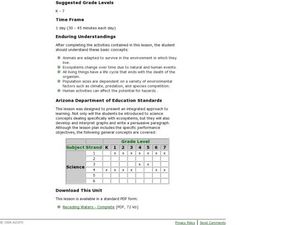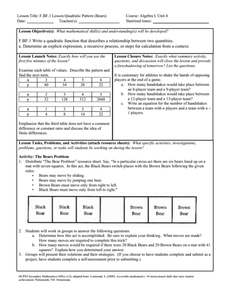Curated OER
HIV and AIDS: Understanding Risk Behaviors
Eighth graders research human sexuality by completing a sexual health worksheet. In this HIV lesson plan, 8th graders define AIDS and list the ways it can be transmitted from human to human. Students assess their own risk and complete...
Curated OER
Hermit Crabs Lifecycle & Stages
Students review the life cycle of land hermit crabs by viewing a poster or transparency. They identify the different body parts of a hermit crab and what each part is used for.
Curated OER
Never Say Die: The CLock of Life
Students explore ways to turn back the genetic clock. They explore cells and mitosis. Students participate in an activity to create a flip book that will animate the process of mitosis. They explain each stage of mitosis.
Curated OER
Effects of Water Pollution on Aquatic Organisms
Students investigate water pollution. They develop an understanding of the behavior of organisms, of the structure and properties of matter, and of natural and human induced hazards by conducting lab tests. They present their data...
Healthy Native Youth
Chapter 5: Learning About HIV/AIDS/STI's and Hepatitis Transmission
Middle schoolers delve deep into facts about HIV, AIDS, Hepatitis, and other STI's by way of discussion and a hands-on activity. Scholars ask and discuss questions anonymously using a Question Box. Two experiments showcase the...
Curated OER
Life Cycles
Students are introduced to the concept of life cycles and identify the growth order and different stages attained by various animals. They view slideshows and video of butterflies and frogs as they change through the various stages of...
Curated OER
My Spelling Words- Spelling List #52
In this spelling activity, students learn to spell 10 words. All words seem to be stages of human life. Students write each word, alphabetize them and write a brief definition for each.
Curated OER
Contacting Outer Space
Students read a newspaper article about a compilation of information on human life that is to be projected into outer space from a pyramid in Mexico. They define vocabulary, complete comprehension worksheets, analyze the use of 'to' plus...
Curated OER
Cultural Representation of Skeletons and Bones
Eighth graders study cultures and beliefs about the final life cycle. In this culture lesson students complete several activities on the origins of Halloween.
Teach Engineering
Clean it Up!
Harness the power of bacteria. Scholars see how using organisms that exist in nature can help solve human problems in the process known as bioremediation. They research and discuss several successful examples, such as using oil-eating...
Curated OER
Have You Seen Me? An Introductory Lesson on the Loss of Biodiversity
Students investigate environmental law and policies involving endangered species as well as discuss human impact on biodiversity through an Internet research project. Students create a milk carton of their "missing" endangered species.
Curated OER
Hopper Hunt: IPM Decision-making in Alfalfa
Learners describe migrations and life cycle pattersn of a key alfalfa pest, the Porato Leafhopper. They define the Economic Inquiry Level and Economic Threshold. Students evaluate data in relation to profit as it applies to IPM. They...
Curated OER
Hawaii's Sea Turtle Exploration
Students investigate the life cycle and body parts of Hawaii's sea turtles. In this sea turtle lesson plan, students watch a video about the turtle life cycle and make a model of a "Honu," sea turtle. They complete an associated worksheet.
Curated OER
Wreck Detectives
Junior archaeologists examine types of artifacts from the Bronze Age on the internet. In collaborative groups, they create a story about a ship from this period and then construct a model of the ocean floor after their ship has sunk....
Curated OER
Experiment to Mimic the Digestive System
What happens to the food that we eat? Middle-school life science learners delve into the digestive process by completing this laboratory activity. They cut a cheese sandwich into smaller parts to represent chewing, smash it to mimic...
Curated OER
Early Humans
Eighth graders work together in groups to examine the earliest civilizations. After reading two stories, they compare and contrast the facts with those stories with other ones they have read. They discuss the different hypothesis on...
Curated OER
Going in Cycles: The Life of an Aluminum Can
Students explore the life cycle of aluminum cans. In this recycling instructional activity, students review the manufacturing process and how to make a closed loop cycle. Students also have the opportunity to present what they've...
Curated OER
The Energy of Life in Zebrafish
Students study the stages of development of an unknown organism. In this zebrafish lesson, students examine and collect data as they use microscopes to view a zebrafish embryo.
Curated OER
Human Genetics-- Complete the Sentences
In this science activity, students demonstrate basic knowledge of human genetics by completing 6 sentences. There is no information on the page but a word bank is provided.
Curated OER
Receding Waters
Students explore the effect of environmental factors on ecosystems. In this wildlife and ecology lesson, students identify and describe the stages in a frog's life cycle. Students participate in a simulation demonstrating the impact of...
NOAA
I Can't Breathe!
The Gulf of Mexico dead zone, an area of low oxygen that kills marine life, costs the United States $82 million every year. Young scientists research anoxic ocean environments then come up with a hypothesis for the cause of the Gulf of...
Curated OER
Fungi
Why did the mushroom go to the party? Because he was a fun guy! Biology learners study fungi while completing this worksheet. Structure is compared to that of other life forms. The life cycle is displayed with colorful diagrams for...
Curated OER
Birth, Growth, and Development
Students study the growth of humans and animals and their various stages. In this developmental lesson students study the life cycle and what that is in humans.
Curated OER
Bears
Young scholars complete a variety of bear-related activities. They sort and graph teddy bears, distinguish between real and non-real bears and research bear life cycles and habitats.

























